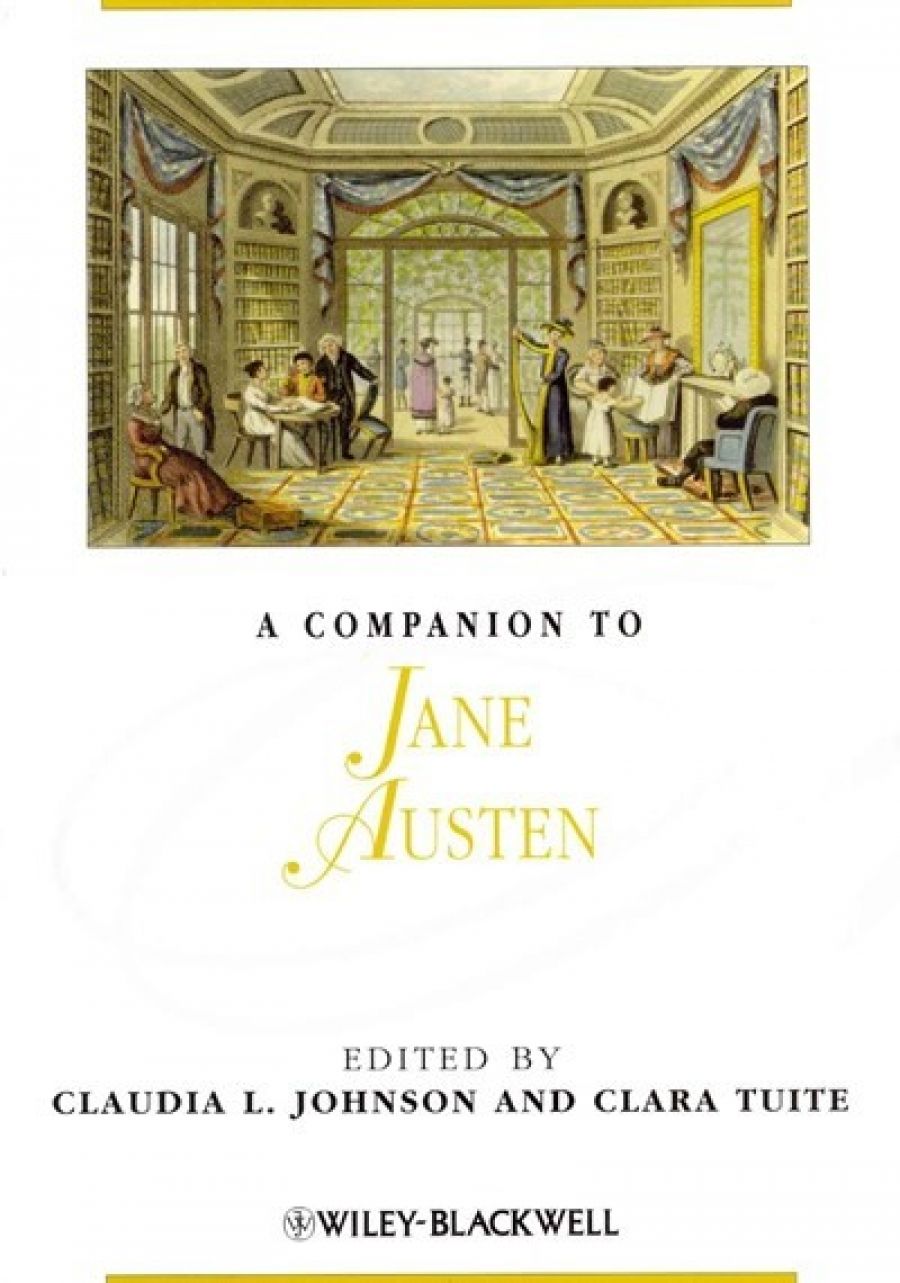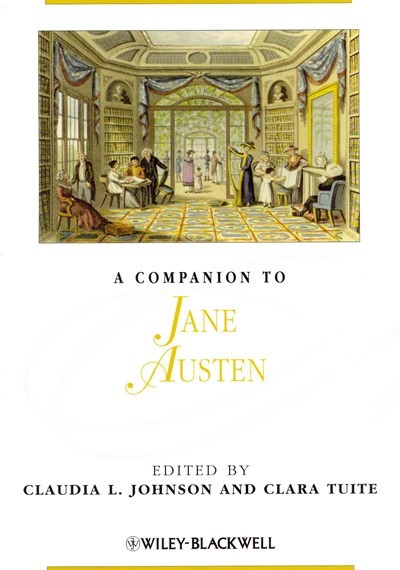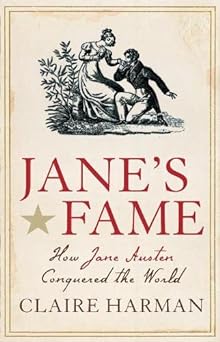
- Free Article: No
- Contents Category: Literary Studies
- Review Article: Yes
- Article Title: Jane Austen™
- Online Only: No
- Custom Highlight Text:
‘If you are afraid of half a dozen speeches,’ cries Mr Rushworth, as the rehearsals for Lovers’ Vows at Mansfield Park are getting underway, ‘what would you do with such a part as mine? I have forty-two to learn.’ Did the editors of the new Blackwell Companion to Jane Austen intend to evoke Mr Rushworth’s self-admiration or his barely disguised anxiety when they commissioned the forty-two essays of this plump, large-format book? The 1997 Cambridge Companionto Jane Austen, by comparison, seems exiguous: thirteen essays of about 7,000 words, edited by two of the Blackwell contributors (Juliet McMaster and Edward Copeland). An updated edition is due later this year, and indeed many of the Blackwell writers also appear in the Cambridge volume.
- Book 1 Title: A Companion to Jane Austen
- Book 1 Biblio: Wiley-Blackwell, $245 hb, 487 pp
- Book 1 Cover Small (400 x 600):

- Book 2 Title: Jane’s Fame
- Book 2 Subtitle: How Jane Austen conquered the world
- Book 2 Biblio: Text Publishing, $34.95 pb, 350 pp
- Book 2 Cover Small (400 x 600):

The Cambridge Companion was directed at readers who sought the ‘contextual setting’ of Austen’s novels. ‘Novels that once seemed so accessible to readers now produce a growing consciousness that profound differences between Austen’s culture and today’s must be addressed.’ True, as anyone who teaches these works knows. Subsequent to this pioneering enterprise, the substantial volume Jane Austen in Context (2005), edited by Janet Todd as part of the new Cambridge edition of Austen, does the contextualising job with impressive thoroughness, in a vast number of short encyclopedia-style entries.
What, then, differentiates the new Blackwell Companion from these competitors? At whom is it aimed? In their introduction, Claudia L. Johnson and Clara Tuite claim that the book ‘seeks not only to describe the present state of Austen studies but also to explore how it both informs and is informed by changes and innovations within the broader field of literary and cultural studies.’ It offers, as well as a ‘scholarly reference’, discussion of ‘the most innovative speculative developments in the field’. Not, in the first instance, intended for undergraduates and the general public seeking information, then? An eye on what might engage the attention of bright honours students and academic colleagues, and prove the hipness of Jane Austen studies? This is an unfair characterisation, of course, and a charge that could be laid at almost any such compilation, particularly when the subject is as familiar as this one. Writers (and editors) must be obsessed by what’s new, what’s useful and is it possible to write an essay that combines both.
Some essays do achieve this ideal; others, to a greater or lesser degree, do not; and that judgement will differ with different readers (as the editors’ introduction strategically suggests). Some of the essays that worked for this experienced Austen reader did the magic, introducing new knowledge that will forever alter my reading of certain aspects of the novels. Gillen D’Arcy Wood’s ‘Austen’s Accomplishment: Music and the Modern Heroine’ is an outstanding example. Pointing out that when we learn that Jane Fairfax has mysteriously acquired a Broadwood piano – a state-of-the-art instrument favoured by Beethoven – we are being informed about the emotional depth and mastery of Jane’s pianism, and further, that Jane could become a professional concert pianist (rather than a governess condemned to tinkling on a parlour piano), Wood proceeds to link this perception to Austen’s own ‘late style’:
Irony, in Austen and late Beethoven, is thus directed towards the same historical object, the parlor room culture of the 1790s … The construction of Jane Fairfax’s repelling ‘reserve’ in Emma as an item of received wisdom is a subtle example of how the conventions of polite discourse – in this case antivirtuosic critique – shape perceptions with such fluid immediacy that only an authorial intervention has the power to expose the ‘truth.’
The truth is that Jane does have a rich (but hidden) emotional life that Emma has been unable to read. Indeed, Jane is metafictionally readable as ‘the closest figure we have for Austen herself – a proto-professional woman living by her talent’. Is this why character and author share a Christian name?
More conventional, but still illuminating, criticism is Margaret Anne Doody’s essay on Austen’s use of figures of speech, the tropes characteristic of each novel: missing similes in Northanger Abbey, broken synecdoche in Sense and Sensibility, abstraction (‘It is a truth universally acknowledged … ’) in Pride and Prejudice, hyperbole as figuring the going ‘beyond natural bounds’ of Mansfield Park, riddles in Emma and metonymy in Persuasion. This is close reading at its finest.
Other excellent essays continue the academy’s recent exploration of Austen’s implication in the social and material conditions of her time. Devoney Looser shows Austen to be as interested in history as her famous contemporary Walter Scott. Mary Poovey has a fascinating essay on the relation between paper money and the gold standard, a relation which models the problems of referentiality and representation in the economic system of early nineteenth-century England, and contributes to the ironic foreclosures of the narrative that end Pride and Prejudice. Deirdre Coleman, one of seven Australian contributors to the Companion, writes helpfully about Austen’s interrogation of ‘how the slave metaphor works’ in Mansfield Park, using contemporary illustrations. Ruth Perry distinguishes illuminatingly between paternal and maternal first cousin marriages in the novels: primogeniture ensures that paternal marriages assist in the accumulation of capital and power; maternal unions celebrate the ‘similarity of habits of mind’ and ‘comfort’ that are the basis of Edmund and Fanny’s relationship. The topic of luxury is covered in Diego Saglia’s demonstration that Austen’s fiction utilises ‘contemporary practices of consumption’ to enrich characterisation: he is particularly helpful on the political significance of General Tilney’s ‘countless’ pineapples. (Try asking an undergraduate class about why the General’s pineapples are pernicious and you will be met with a blank stare – it is not that they are bad readers of Austen, they just lack any knowledge of the history of agriculture.)
The final section of the Companion covers the currently fashionable topics of ‘Reception and Reinvention’, including films, continuations and rewritings of the novels, and Internet subcultures such as the ‘Republic of Pemberley’. Readers can make their own judgements about today’s manifestations of Austen-mania; they don’t need an academic Companion to assist them. But they might well be delighted to find it has all happened before, in the ‘silver fork novels’ of the early nineteenth century, investigated by Edward Copeland with an acute eye for their Austen plagiarisms; and in the colonial New Women novels (including those by Catherine Spence, Miles Franklin and Ada Cambridge) covered by Katie Trumpener (whose proofreaders ought to have corrected her ‘Pemberton’ for Pemberley and ‘The End of My Career’ for My Career Goes Bung).
Regardless of academic aspirations, all Companions are obliged to offer a version of the writer’s life and essays on the novels. With Austen, do we really need the latter, separate from the kind of revisionist work I have listed above? Surely only those who already know the novels and their basic themes would be picking up this volume. On the other hand, Kathryn Sutherland offers a masterly discussion of ‘Jane Austen’s Life and Letters’ as the volume’s opening essay. Her scholarly eminence in this field has been the subject of recent debate in the British press: she has accused Claire Harman, the author of the populist paperback Jane’s Fame: How Jane Austen Conquered the World, of plagiarising Sutherland’s Jane Austen’s Textual Lives: From Aeschylus to Bollywood (2005).
Only comparison of passages of text can resolve this spat: what is true, however, is that Sutherland’s book is the best kind of academic research – wonderfully original and detailed, rivetingly readable. Harman’s book is much more lightweight, certainly less detailed as to matters of textual history and editorial practice. Harman is rather chatty and given to exclamation marks: ‘Phew!’ she comments at one point, though at another her wit perfectly hits off the Austen film industry: ‘Cue the kiss, the climax of every Jane Austen film. More than one kiss … would be … like demanding a second communion wafer.’ Whereas Sutherland writes at length (in 2005) about the ‘fidelity’ debate around the Austen film adaptations, Harman sees them simply as an aspect of ‘Jane Austen™’, along with YouTube compilations and Austen-worship websites. The films will surely survive as craft-work or better; the amateur subcultural ephemera will no doubt disappear. The novels remain.


Comments powered by CComment